|
Ogden Shops Construction 1912
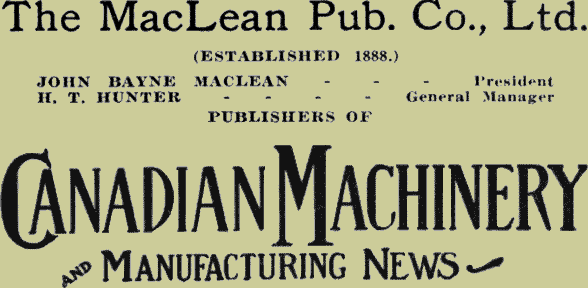
A Monthly newspaper devoted to machinery and manufacturing
interests, mechanical and electrical trades, the foundry,
technical progress, construction, and improvement.
 Introduction Introduction
By May 2012 the famous Ogden Shops at
Calgary will be no more after 100 years of operation. Construction of Ogden Shops began on 1 Apr 1912 with the locomotive shop becoming
fully operational by 17 Mar 1913. The following article describes the composition and construction of these Canadian Pacific Railway shops
at Ogden and was published on 29 May 1913 by the MacLean Publishing Company Limited.
 29 May
1913 29 May
1913
Description of New C.P.R. Shops, Ogden, near Calgary, Alberta by C.T.D.
The Canadian Pacific Railway Co. has recently put in operation, at Ogden, near Calgary, Alberta, a large shop
plant of more than ordinary interest by reason of its size, its complete and modern character, and the speed with which it was created.
The work was designed and built in entirety by Westinghouse Church Kerr Co., consulting and constructing engineers, of Montreal and New
York, working under the direction of Mr. J.C. Sullivan, Chief Engineer of the Western lines of the Canadian Pacific Railway, and Mr. J.E.
Brooks, Divisional Engineer.
Problems Due to Location
The shop location at Ogden (named in honor of the vice-president of the railway), 4 1/2 miles from Calgary and about 2,250 miles from
Montreal. Its distance from these sections of the country where the greater part of the construction materials, machinery, and equipment
were produced, constituted the first and one of the most important problems. A second important problem arose on account of the
construction season being extremely short, owing to the high latitude, frost remaining in the ground until about April 1st, and returning
with snow as early as October first. A third very important problem was the comparative scarcity of labor in the Canadian North-west, this
condition being greatly aggravated during the late summer months when harvesting begins and all labor markets are practically drained of
men. Plans had, therefore, to be drawn, materials ordered, deliveries made, and complete field organization perfected so that the shops
could be closed in between April 1st and December 1st, and sufficiently heated so that inside work could be continued after cold weather
had set in. How this was done will be seen from the accompanying progress diagram.
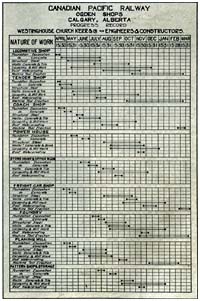 The plant consists in general of main locomotive shop, including erecting, machine, blacksmith, and boiler shops, tender and wheel shop,
pattern shop and pattern storage, foundry, storehouse and office buildings, material platforms and scrap dock, oil house, coach repair and
paint shop, freight car repair shop, planing mill, boiler and compressor house, and a 1,260 ft. yard crane. Miscellaneous structures,
include transfer table and pit for coach shop, mess hall, driven wells and water tower, all service system, such as drainage, sewage, fire
protection, water supply, etc.
The plant consists in general of main locomotive shop, including erecting, machine, blacksmith, and boiler shops, tender and wheel shop,
pattern shop and pattern storage, foundry, storehouse and office buildings, material platforms and scrap dock, oil house, coach repair and
paint shop, freight car repair shop, planing mill, boiler and compressor house, and a 1,260 ft. yard crane. Miscellaneous structures,
include transfer table and pit for coach shop, mess hall, driven wells and water tower, all service system, such as drainage, sewage, fire
protection, water supply, etc.
Main Locomotive Shop
This is building designed to contain the erecting shop, machine shop, blacksmith shop, erecting shop, and boiler shop. The erecting shop
is of the traverse lift-over type, it contains 35 bays, each 22 feet between centres, and is 778 ft. long by 75 ft. wide. The entire area
is served by two traveling cranes, carried on two levels. A 120 ton crane furnished with two 60-ton trolleys is carried on the upper level
and is used for transferring, wheeling, and un-wheeling locomotives and handling parts. One of the trolleys on this crane is equipped with
a ten-ton auxiliary hoist for handling light material at a high hoisting speed. Another ten-ton traveling electric crane operates at high
speed and serves the entire area of the erecting shop, for handling material in that shop and transferring same to the blacksmith and
machine shop. The machine shop and boiler shop are located in adjacent bays on either side of the erecting shop.
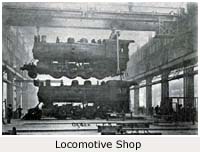 Provision is made on the crane columns in the erecting shop for attaching portable jib cranes for use in dismantling and erecting material
on the front ends of locomotives. These cranes are placed where desired by means of the overhead traveling electric cranes. The entrance
for locomotives to the erecting shop is provided through four doors, located on the west side, two of these doors being located at either
end. For providing additional means for entrance of locomotives, six door openings are provided in the east wall of the machine shop, two
of these being at the north and four at the south end. All of these entrance tracks are connected up with the erecting pits of the several
stalls where they enter the building, so as to permit the locomotives moving into and out of the shop through these entrances should this
movement become desirable or necessary.
Provision is made on the crane columns in the erecting shop for attaching portable jib cranes for use in dismantling and erecting material
on the front ends of locomotives. These cranes are placed where desired by means of the overhead traveling electric cranes. The entrance
for locomotives to the erecting shop is provided through four doors, located on the west side, two of these doors being located at either
end. For providing additional means for entrance of locomotives, six door openings are provided in the east wall of the machine shop, two
of these being at the north and four at the south end. All of these entrance tracks are connected up with the erecting pits of the several
stalls where they enter the building, so as to permit the locomotives moving into and out of the shop through these entrances should this
movement become desirable or necessary.
Machine Shops
The machine shop for heavy machine tools is located parallel with the adjoining erecting shop on one side, and is 60 ft. 9 inches wide and
of the same length as the erecting shop. A high speed traveling crane of 10-ton capacity covers the entire area of this shop. Material can
be brought in through a door provided in the end of the building, it being brought up to the end of the machine shop by the traveling
electric yard crane which travels across the end and outside of the locomotive shop.
Space for the lighter machine tools is provided in a shop 60 ft. 9 inches wide, parallel with and alongside the heavy machine shop and of
the same length as that shop. An overhead trolley beam is also provided on the bottom chord of the roof truss to permit using a travelling
electric trolley for handling material longitudinally. Provision has been made for a foreman's office elevated above the floor and having
liberal glass surface in the walls so as to give the best possible view of the shop.
Blacksmith and Boiler Shops
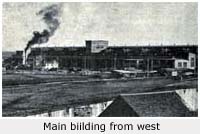 The blacksmith shop is located alongside and parallel to the erecting shop on the opposite side of the machine shop. This building
consists of two bays each 332 feet long, and 60 feet 9 inches and 50 feet wide, respectively. Space is provided for heavy forging work,
steam hammers, etc., in the building immediately adjoining the erecting shop. The blacksmith shop will not be served by a traveling crane,
but provision has been made for jib cranes to handle the material from steam hammers, forgings, etc. In a building of lower cross-section
alongside, are located the furnaces, bolt headers, and other blacksmith shop machinery. This portion is served by a trolley throughout its
full length, to facilitate the longitudinal movement of the material.
The blacksmith shop is located alongside and parallel to the erecting shop on the opposite side of the machine shop. This building
consists of two bays each 332 feet long, and 60 feet 9 inches and 50 feet wide, respectively. Space is provided for heavy forging work,
steam hammers, etc., in the building immediately adjoining the erecting shop. The blacksmith shop will not be served by a traveling crane,
but provision has been made for jib cranes to handle the material from steam hammers, forgings, etc. In a building of lower cross-section
alongside, are located the furnaces, bolt headers, and other blacksmith shop machinery. This portion is served by a trolley throughout its
full length, to facilitate the longitudinal movement of the material.
The space for the boiler shop is provided in a two-bay building, alongside and parallel with the erecting shop at the end of the
blacksmith shop. It is 352 ft. long, and of the same width as the latter. That part of the boiler shop immediately adjoining the erecting
shop is provided with a 40-ton traveling electric crane, equipped with two 20-ton trolleys serving the entire area, for handling boilers
and other material. The riveting tower is located between two of the roof trusses in the end of the boiler shop, with a 25-ton crane for
serving the hydraulic riveter.
In the outer of the two bays of the boiler shop, space is provided for a flue shop and boiler shop tools. The entire length of this space
is served by a 3-ton overhead traveling trolley. Space for a flue rattler is provided immediately outside and adjacent to the low bay of
the boiler shop. An entrance track is provided through the outside wall of the boiler shop on which boilers or other equipment going to
this department can be delivered on cars under the traveling crane, for unloading, or may be loaded out for shipment in the same way. This
facilitates the handling of boilers from steam shovels, pile drivers, Lidgerwoods, etc. Jib cranes are provided for serving the individual
machines in the boiler shop where such service' may be necessary.
Heating Light & Power, etc.
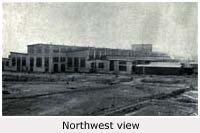 The heating throughout is done by an indirect fan system. For distributing the heated air underground concrete and tile duets are used.
The general illumination consists of Cooper-Hewitt lamps with circuit and plug boxes for extension loop cords to provide lighting for the
interior of the locomotive boilers on the erecting floor. Toilets, lavatories, and metal lockers are provided in the various departments
of this shop. A suitable system of piping is provided for distributing live steam, compressed air, and fuel oil, also water for fire
protection, drinking, and hydraulic pressure. Outlets for compressed air are provided in duplicate in the sides of the engine pits to
supply operating pneumatic tools.
The heating throughout is done by an indirect fan system. For distributing the heated air underground concrete and tile duets are used.
The general illumination consists of Cooper-Hewitt lamps with circuit and plug boxes for extension loop cords to provide lighting for the
interior of the locomotive boilers on the erecting floor. Toilets, lavatories, and metal lockers are provided in the various departments
of this shop. A suitable system of piping is provided for distributing live steam, compressed air, and fuel oil, also water for fire
protection, drinking, and hydraulic pressure. Outlets for compressed air are provided in duplicate in the sides of the engine pits to
supply operating pneumatic tools.
In the main locomotive shop, the electrical feeders from the power company transmission lines are carried in underground ducts, bringing
the current at the voltage delivered by the power company, namely, 2,200 volts, to a sub-station located adjacent to and immediately
outside the low machine bay, the transformers for stepping down to 440 volts being located in this sub-station. In this sub-station, two
motor generator sets for supplying direct current are also located. The switchboard is also located in this sub-station for controlling
the power and lighting circuits in the machine shop, and for the tender shop and foundry. As far as possible, distributing feeders are
carried in conduits beneath the shop floor, thereby minimizing, the amount of exposed wiring in the shops.
The building containing all of the above departments of the locomotive shop is constructed of structural steel frame carried on concrete
foundations. The exterior walls up to the window-sill line are of concrete, above the window sills they are of hollow-tile plastered.
Ample window area is provided in the side walls and in roof monitors and skylights so as to give sufficient natural lighting. Mod
ventilation is obtained through ventilators in the monitors and skylights, and by the use of swinging sashes in the vertical walls.
With the exception of the blacksmith shop and a portion of the boiler shop, the floor throughout is constructed with a 1 1/2 inch asphalt
mastic wearing surface which is underlaid with a rough concrete slab about 6 in. thick. In the blacksmith shop and a portion of the boiler
shop, the floor is of cinders. The roof sheathing is constructed of 2 x 4's, surfaced on one side and one edge, and spiked together on
edge, thus affording good fire resistance qualities and materially reducing the heat losses. The roof water-proofing is four-ply tarred
felt, pitch, and gravel, with copper flashing. Suitable drain leaders are provided and connected into underground tiled drains to carry
off the water from the roof. The large skylight on the erecting shop bay is of steel bars, lead covered with ribbed wire glass.
Tender and Wheel Shop
This building is constructed of structural steel frame and with steel roof trusses. Otherwise the general construction of this building is
similar to that described for the main locomotive shop. It is an L-shaped structure, 263 ft. x 80 ft., wide, with the L portion 180 ft.
long by 80 ft. wide, and affords space for making repairs to locomotive tenders, steam-shovels, and other maintenance-of-way equipment.
That portion of the shop intended to receive the equipment to be repaired is spanned over its entire area by a 20-ton high-speed traveling
electric crane equipped with two 10-ton trolleys. Longitudinal tracks on 20 foot centres extend to the doors in the building wall and a
car puller is installed for moving the equipment into and out of the shop. A sufficient number of tracks extend through the rear wall of
the building to facilitate the movement of material into the shop.
In the L portion of the building, of lower cross section, space is provided for steel tire wheel lathes, wheel and axle machinery, and
such other tools as required. A depressed tank, carries along the ends of the wheel storage tracks outside, facilitates unloading and
loading of wheels and axles. The heating, lighting, and service equipment is similar to that described for the main locomotive shop.
Pattern Shop and Pattern Storage
Space for the pattern shop and pattern storage is provided in a separate building located adjacent to the foundry, a fire wall separating
the pattern shop from the pattern storage. The general construction of the building is the same as that of the other buildings, the roof
being of slow burning mill construction. The structure is 162 ft. long by 31 ft. wide and is heated by direct system and lighted with
keyless socket marine type incandescent lamps. A sprinkler system is provided for fire protection.
Foundry
The grey iron foundry building is 203 ft. long by 80 ft. wide, constructed with two bays. The frame is of structural steel carried on
concrete footings. The general construction is the same as that described for the other buildings except that the floor is of the usual
clay type used in foundries, the roof over the cupola room is of corrugated asbestos.
The bay of higher cross-section is served over its entire length by a 10-ton high-speed travelling electric crane. Jib cranes, attached to
building columns are provided, and are so arranged that they may be removed from one location to another if desired, being handled by the
traveling electric crane. In the side bay of lower cross-section space is provided the entire length by a 10-ton high-speed traveling
electric crane. In the side bay of lower cross-section space is provided for core making and shop moulding floor. The charging floor for
the cupola is located in the centre of the lower bay.
Heating is by the indirect fan system with underground tile and concrete hot-air ducts. For general illumination, flaming arcs are used in
the high bay and ordinary arcs in the low bay, with outlet boxes for extension lamp cords. Toilets, lavatories, and conveniences for the
men are provided, also steam, air, and water service, for fire protection and drinking purposes.
The location of this building alongside and parallel to the travelling electric yard crane enables the unloading of scrap and pig-iron to
be taken care of by the yard crane also reduces to a minimum the handling of the castings from the foundry to storage, to the main shop,
or in loading for shipment.
Storehouse and Office Building
This building is 252 ft. 6 in. long by 60 ft. wide. One end of the building for a length of 40 feet is carried up three stories, and
contains offices on the second and third floors, and a fire-proof vault. The remainder of the building, for storehouse purposes, is two
stories high, and contains electric elevator, platform scales, material bins, and shelving. The walls are constructed of hollow-tile
blocks on concrete foundations, the framing being of heavy timbers, with roof sheathing of two by four's surfaced on one side and one
edge, and spiked together on edge. The foundations are carried up to bring the floor of the storeroom to car door height. The necessary
toilet and lavatory facilities are provided.
The offices are heated by direct radiation the remainder of the building being heated by the indirect system. The lighting is by
incandescent lamps and fire protection is by automatic sprinklers. The ground floor of the storehouse has 1/2 inch asphalt mastic surface,
while the other floors throughout the building are of wood. The window arrangement is such as to best accommodate the material bins and
shelves without interference with good lighting.
The storehouse is located parallel with the main locomotive shop, the space between these two buildings being spanned by a high-speed
travelling crane which can be utilized to handle all heavy material to and from the cars from the storage space provided between the
storehouse and the erecting shop. The use of this crane practically eliminates manual handling of heavy material, and permits handling
numerous small parts in quantities, when contained in suitable receptacles.
Material Platforms and Scrap Dock
A material platform 90 ft. wide and about 350 ft. long, abuts one end of the storehouse. This platform is also carried along either side
of the storehouse where it is 15 feet wide. It is constructed of concrete retaining walls filled in with earth, and a top dressing of
cinders covers the fill except alongside of the storehouse, where plank covering is laid. The platform extends to, and along the sides of,
the oil house.
Oil House
For storing and distributing oil, a separate building is provided convenient to, but located far enough away from the storehouse and other
buildings to eliminate the fire risk. It is constructed with tile walls (plastered on the exterior), on concrete foundations, with a
concrete basement at one end for the tanks which contain the oil for local distribution. The roof is of reinforced concrete slab, as is
also the floor of the pump room over the basement. That part of the building used for storing oil in barrels has a cinder floor. The pump
room is partitioned off with a brick wall carried up to make a fire wall.
Ten oil tanks with measuring pumps are installed and provision is made for conveniently emptying the oil from barrels into tanks in the
basement. The oil house basement is heated by the direct system, to the high temperature necessary to render the oil fluid during
extremely cold weather. The direct system being also used to heat the rest of the building. The lighting of the building is by keyless
socket marine type incandescent lamps. Fire protection, including sprinklers, is installed.
Coach Repair and Paint Shop
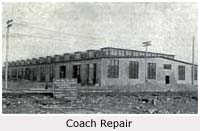 The building containing these departments is 362 feet long by 146 feet wide, having 15 tracks on 24 foot centres. It is constructed with
hollow building tile carried on concrete foundations. Heavy timber posts support the roof which is of slow burning mill construction.
Otherwise, the construction is the same as that described for the main shop building. Space is provided along one side of the building for
varnish rooms, upholstering, office, sub-store, paint storage, heating plant, and air brake repairs. When necessity arises for increased
shop capacity in this department, it is proposed to obtain such increase by the erection of another shop on the opposite side of the
transfer table.
The building containing these departments is 362 feet long by 146 feet wide, having 15 tracks on 24 foot centres. It is constructed with
hollow building tile carried on concrete foundations. Heavy timber posts support the roof which is of slow burning mill construction.
Otherwise, the construction is the same as that described for the main shop building. Space is provided along one side of the building for
varnish rooms, upholstering, office, sub-store, paint storage, heating plant, and air brake repairs. When necessity arises for increased
shop capacity in this department, it is proposed to obtain such increase by the erection of another shop on the opposite side of the
transfer table.
Heating is by the indirect fan system with underground concrete and tile ducts while lighting is by incandescent lamps. Compressed air,
steam, and water services, including fire protection and automatic sprinklers are provided. Toilets, lavatories, and conveniences for men
are also fitted in this shop.
Freight Car Repair Shop
The freight car repair shop is 231 ft. wide by 303 ft. long, and contains 8 repair tracks, spaced in pairs with industrial track between
each pair of repair tracks. A tile wall partitions off the shop, 50 feet wide along one side, which will contain the blacksmiths forges,
tools, heating plant, foreman's office, toilets, and lavatories.
The building is of structural steel frame with tile walls, plastered on the outside, and of sawtooth roof construction. The general
construction, otherwise, is the same as that of the other shop buildings. An overhead trolley beam is provided to permit handling timbers
with a trolley into the shop. Compressed air, steam, water service piping, and fire protection, including automatic sprinklers, are
supplied.
Heating is by the indirect fan system with underground concrete and tile ducts while lighting is by 100-watt tungsten lamps. The location
of this building alongside the lumber yard permits handling lumber so that it can be passed through into the shop without rehandling.
Planing Mill
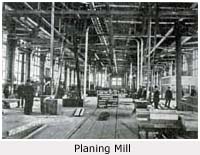 This building is 303 ft. long by 80 ft. wide, and contains the wood-working machinery. The frame is of structural steel carried on
concrete footings. The general construction of the building is the same as that of the other shop buildings. A track extends through the
building longitudinally to permit movement of material inward at one end to the various machines, and out through the opposite end with
the minimum amount of handling. The building is located so as to be convenient to the passenger and freight car shops. The lumber yard is
located back of, and at one end, of the planing mill.
This building is 303 ft. long by 80 ft. wide, and contains the wood-working machinery. The frame is of structural steel carried on
concrete footings. The general construction of the building is the same as that of the other shop buildings. A track extends through the
building longitudinally to permit movement of material inward at one end to the various machines, and out through the opposite end with
the minimum amount of handling. The building is located so as to be convenient to the passenger and freight car shops. The lumber yard is
located back of, and at one end, of the planing mill.
Suitable piping has been provided for distributing compressed air and water, and the fire protection system includes automatic sprinklers.
Provision is made for toilets, lavatories, and metal lockers for the men employed in this department, while heating is by the indirect fan
system with galvanized iron heating ducts. Lighting is by mercury vapor lamps.
Power House
The power house contains sufficient space for 2,100 horse-power water tube boilers required to provide steam for heating the shops and for
other purposes for which steam is required. The building is constructed with brick walls carried on concrete foundations, with steel roof
trusses and supports for coal bunkers. The chimney is of reinforced concrete, 200 feet high, with a minimum diameter of 9 feet.
The overhead coal bunker for each boiler is divided by a reinforced concrete partition into two compartments, to provide for storing and
burning two kinds of coal. An overhead storage bin for ashes is provided, from which bin the cinders can be discharged by gravity into
cars alongside the building. A concrete dumping hopper is provided outside for dumping coal from cars. A pivot steel elevator raises and
discharges the coal into the overhead bunker. A skip-bucket with electric hoist handles the ashes into the ash bin.
The boiler units are of 350 horsepower rating, and are set in three batteries of two each. Five of the boilers are equipped with chain
grate stokers. The sixth boiler has shaking grates for burning shavings and other planing mill refuse.
Space is also provided for three electrically driven air compressors each of a capacity of 1,500 cubic feet of free air per minute, only
two of these being meantime installed. Transformers and distributing panel are located in this building for transforming and distributing
light and power current to the shop yard, freight car shop, planing mill, and coach repair shop. There is no direct current apparatus in
this station. Provision has been made for two incoming 2,200-volt lines, one of 2,000 kilowatt, and the other of 1,000 kilowatt capacity
for breakdown service.
The steam required for the steam hammers and other shop purposes during the summer time can be supplied by one boiler. The boiler capacity
provided will afford one spare boiler during extreme weather conditions when the maximum steam demand occurs.
Yard Crane
A yard crane runway, 1,260 feet long, extends from the west line of the locomotives shop and carries a 10-ton high-speed traveling
electric crane with 80 foot span, serving the material yard and a portion of the store house platform and scrap dock. One of the
storehouse tracks extends through under this crane resulting in ample space being given for the storage of material alongside the
storehouse, foundry, and locomotive shop. By this arrangement, heavy material can be unloaded, stored, and rehandled to the shop or loaded
out again by the crane for shipment, practically eliminating manual labor in the handling of all heavy materials.
Miscellaneous Structures
The transfer table for serving the coach shop is 75 feet long, and of 150 tons capacity. It is equipped with an electric motor, and with a
concrete transfer table pit 400 feet long, extending out far enough at either end of the building to provide entrance and egress at both
ends.
The mess building, 269 feet 6 inches long by 31 feet 10 inches wide, is of wooden frame construction, covered outside with sheathing,
building paper and siding, and sealed on the inside with metal sheathing. It has a concrete floor, and contains a dining room for the
officials, together with kitchen and pantry. Sixty feet of the length of the building is carried up two stories to provide an apprentice
schoolroom and quarters for the help. Heating is by the direct system, and lighting by incandescent lamps. There are also two small
buildings located near the freight repair tracks for blacksmith shops and workmen's tools, and in one of them is a small toilet and
office. Dry kiln, material bins, plate, and iron racks, coal and coke sheds are also provided.
For obtaining water for shop purposes, there have been put down two 8 inch wells, equipped with electrically operated pumps. To supplement
this supply, and to provide a main source of supply for fire protection, the City of Calgary has brought down into the shop site, to a
point midway the length of the main shop building on the west side, a 10 inch cast iron water main. The shop service and fire lines are
connected onto this main, and into a steel tank of 125,000 gallons capacity, which is erected on a 70 ft. steel tower, principally for use
in connection with automatic sprinklers in the various buildings where these are installed. A complete fire protection system has been put
in with hydrants distributed about the shop yard.
The sewage system in the shop yard may be divided into the sanitary and storm sewers. The City of Calgary is furnishing the main sanitary
sewer, beginning at the east line of the freight car shop and extending to the eastern boundary of the shop property. All the sanitary
sewage lines from the various buildings are connected into this sewer. Storm sewers are provided where necessary to carry off the roof
water from the buildings where the roof construction is such that this cannot be discharged onto the ground.
The Work of Construction
The location of the shops is about four and one-half miles east of Calgary, practically on the open prairie, and at the beginning of
construction, arrangements had to be made to house and board on the shop property a considerable quantity of labor. To this end, frame
bunk houses were built with two tiers of bunks on each side of the building, eight bunks long, each house having a capacity of 32 men.
Stoves were placed in the centre aisle and benches along the sides of the lower tier of bunks. On the coming of summer, and as the labor
forces were increased, some of the men were housed in standard 12 x 14 wall tents which accommodated four men each. A large mess room and
kitchen and storeroom space were also fitted up with a capacity for feeding about 400 men at one time.
Great care was exercised in keeping the camp in a sanitary condition. This work was largely under the direction of doctors who visited
each day to take care of possible sickness, and an arrangement was also made, whereby those who were employed on the work voluntarily
contributed a small amount from their wages for the services of these doctors. This amount also included hospital service when necessary.
Due to this care, there was very little sickness on the job.
As there was no accommodation for men with families near the shops, the Railroad Company put into temporary service a train to carry the
men back and forth from Calgary, and several hundred men went back and forth on this train each day. This arrangement helped the situation
considerably, especially as the season advanced and all kinds of skilled and unskilled labor became more difficult to obtain. A standing
order was placed through several labor agencies in Calgary to send men daily to the job. As the work neared completion, the bunk houses
and mess house previously mentioned were turned over to the railroad to take care of their own men, who were at that time living in cars
on the property. This, of course, released the cars and permitted their use at other points.
The progress schedule will show the prosecution of the work, but it should be again pointed out that it was not possible to break ground
until 1 Apr 1912. and by 17 Mar 1913, the locomotive shop was in full operation. When the magnitude of the work is considered as also its
distance from the larger centres, it will be appreciated that a record for prompt performance has been
established.
 News
Articles News
Articles
1 Apr 1988 - Ogden Hails 75th
1 Aug 2001 - Ogden Shops in Alstom Hands
1 Apr 2005 - New Home Gets 2816 All Steamed Up
1 Jul 2005 - The Railway's "Home-Made" Locomotives
10 Jan 2011 - History of Ogden Shops
26 Apr 2011 - Historic Calgary Rail Yard Ends Era
 Associated
Web Sites Associated
Web Sites
Canadian Pacific Railway
Macleans Magazine
Alstom Ogden Shops
|